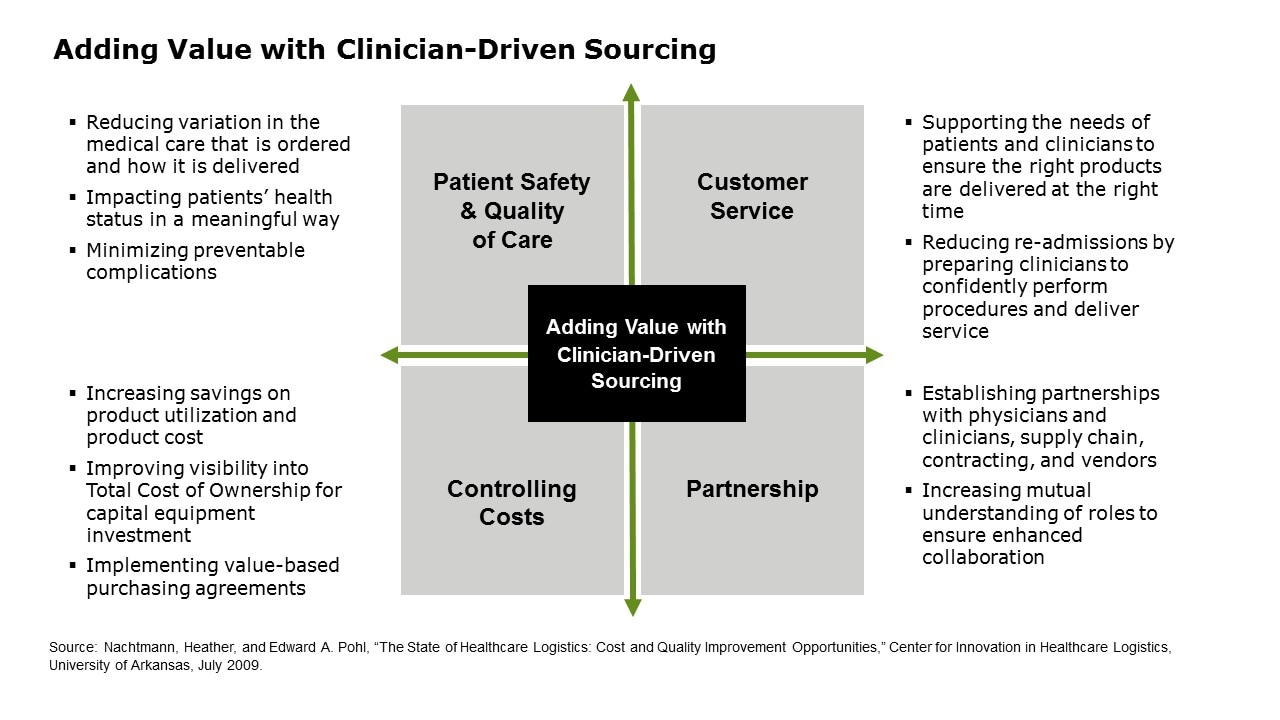Clinician-driven sourcing for medical supply chains has been saved

Analysis
Clinician-driven sourcing for medical supply chains
Creating value within federal health care organizations
This report explores how clinician-driven sourcing can create value for federal health care organizations. The aim is to provide strategic tactics that can elevate medical supply chain management within federal health care organizations.
Explore content
- Clinician-driven sourcing
- Value creation
- Implementing a clinician-driven sourcing strategy
- Success factors
- Take action
Clinician-driven sourcing
Health care supply chain leaders are continually being challenged to reduce operational costs without sacrificing patient safety, product quality, or clinical support. Commercial health care organizations have embraced clinician-driven sourcing, engaging physicians and clinicians within the sourcing process to achieve tangible results to reduce unit price, improve clinical protocols, and standardize medical/surgical and clinically preferred products. Given the demonstrated success in commercial health care organizations, federal health organizations may likely benefit by embracing a clinician-driven sourcing approach.
Clinician-driven sourcing creates value for federal health care organizations by increasing partnerships between clinicians and procurement staff, improving safety and quality of care for patients, and enhancing customer service while reducing overall spend. For this sourcing strategy to be effective, it must be rooted in an organization's willingness to embrace change and should emanate throughout the leadership structure. The deliberate execution of a clinician-driven sourcing strategy provides the required foundation to elevate supply chain practices within federal health care organizations.
Value creation
Clinician-driven sourcing creates value for health care organizations by increasing partnerships between clinicians and procurement staff, improving safety and quality of care for patients, and enhancing customer service while reducing overall spend. It is rooted with a value analysis structure lead by an executive-sponsored committee and engages stakeholders in various operational capacities based upon products and services reviewed. The infographic provides an example of a value analysis structure used in many commercial health care organizations.
Federal health care organizations must strive to provide quality patient care in a safe environment that is cost efficient and involves the voice of the clinician.

Implementing a clinician-driven sourcing strategy
Phase one: Plan–Focuses on planning and preparing sourcing activities and value analysis teams to ensure the appropriate structure is in place for clinician involvement.
Phase two: Develop–Ensures that the development of health care facility supply and equipment needs includes the voice of the clinician from initial requirements development through acquisition strategy formulation.
Phase three: Execute–Involves executing contracting and procurement actions to acquire the medical supplies, equipment, and services based on the collaborative efforts between clinicians and supply chain staff.


Success factors
- Commitment to change must be driven by leadership and endorsed by clinician and procurement staff as well as end users
- Product and service decisions should be determined through a logical and objective process driven by clinicians and clinical research
- Spend, utilization, and any other market data used to make sourcing and procurement decisions should be based on accurate and verifiable sources
- Measurement and tracking of performance should be monitored to ensure that any specified business goals and objectives are achieved
- Organizational leadership should assemble a change champion network of clinicians who are responsible for supporting the supply chain transformation within their hospitals
- Providing the best care to patients should be the primary driver of this standardization strategy, rather than focusing on cost optimization

Take action
The deliberate execution of a clinician-driven sourcing strategy provides the required foundation to elevate supply chain practices within federal health care organizations. Physicians, clinicians, and supply chain professionals, who are all committed to the well-being of patients and to procuring the right items at the best price, must work together to ensure that sound sourcing decisions are based on patient safety and quality of patient care. Using a clinician-driven sourcing standardization approach will minimize variation in medical practice and reduce the amount of time that clinicians must spend learning how to use functionally equivalent products.
For this sourcing strategy to be effective, it must be rooted in an organization's willingness to embrace change and should emanate throughout the leadership structure. Federal health care organizations must strive to provide quality patient care in a safe environment that is cost efficient and fully involves the voice of the clinician.
Sources
1 Meyer, S., O'Daffer, E., Stevens, A., and Callinan, L. "The health care supply chain top 25 for 2016," Gartner, November 2016, pp. 1–29. Accessed 15 August 2017.
2 O'Daffer, E., and Johnson, J. "Health care supply chain best practice series: Intermountain saves $24 million by embracing standardization," Gartner, June 2016, pp. 1–11. Accessed 15 August 2017.
3 Nachtmann, Heather, and Edward A. Pohl, "The state of health care logistics: Cost and quality improvement opportunities," Center for innovation in health care logistics, University of Arkansas, July 2009.
Explore related insights
Meet the authors
| Kelly Marchese Principal | Supply Chain Strategy leader kmarchese@deloitte.com +1 404 631 2240 |
Dr. Bruce Green Managing director and chief medical officer brucegreen@deloitte.com +1 571 882 6290 |
| Crystal Williams Manager | Deloitte Consulting LLP cryswilliams@deloitte.com +1 571 228 8137 |
Recommendations
Technologies for supply chain innovation
Explore benefits and key levers for evaluation and adoption

